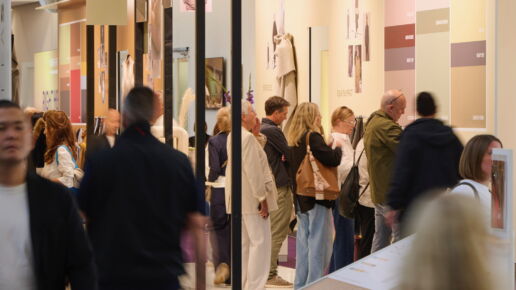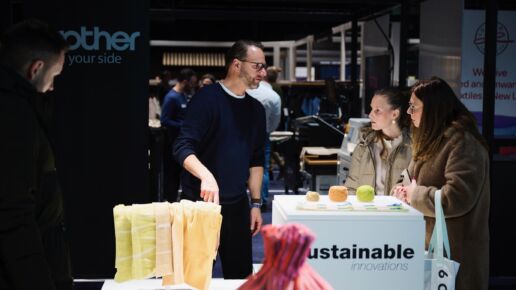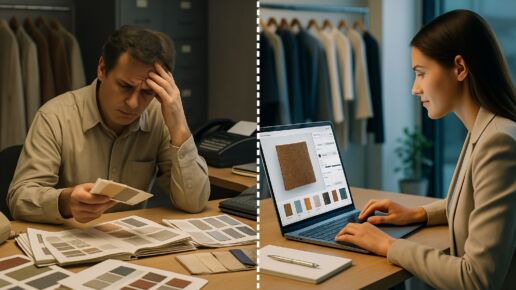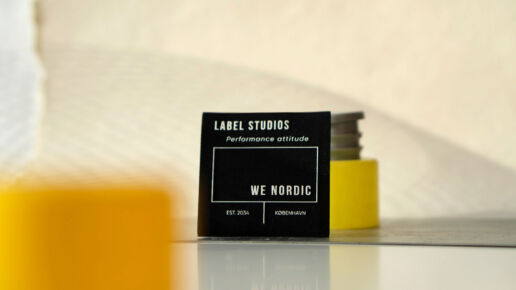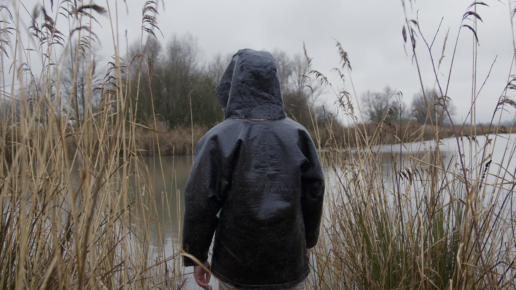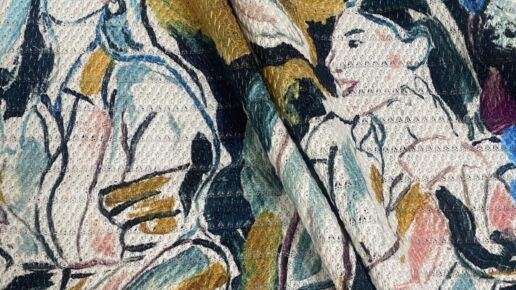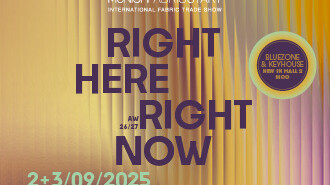In the atmospheric industrial charm of KEYHOUSE, Hall 7, progressive suppliers and global players from cross-industry sectors will be showcasing their latest new developments and innovations. On over 1,000 square metres, you will find trend-setting future fabrics and new process technologies – be it in terms of sustainability, circular economy, digitalisation & AI, traceability, textile dyeing or finishing. Staged as an interactive think tank, future-oriented show cases will be in the spotlight alongside sustainable innovations.
KEYHOUSE is also home to the main lecture forum of MUNICH FABRIC START with exclusive keynotes, panel discussions, trend presentations, Q&A sessions & expert talks by international industry insiders. Be inspired by the wide range of events at KEYHOUSE.
Momentum.
What is fashion? Fashion is creativity and expressing yourself. That’s beautiful and it gives every one of us a certain identity. It’s made out of fabrics, so to say “resources”. These resources are finite. However, 30% of overproduced clothes are being dumped every year, equating to roughly 5 million tonnes, or 12 kg per person in the EU. To put it in simple terms: This is not beautiful anymore…
To limit these effects and to promote recycling & repair systems, the European Commission has imposed the “Ecodesign for Sustainable Products Regulation” (ESPR), which sprung to life on July 18, 2024. This isn’t just another piece of legislation. It’s a game-changer for the European market, aimed squarely at making sustainable products the new norm. Think of it as the EU’s bold stride towards a greener future, wrapped up in a robust action plan that redefines how products are designed, used, and recycled.
Denmark – H7 KH | K 03 A
“This isn’t just another piece of legislation. It’s a game-changer for the European market, aimed squarely at making sustainable products the new norm. Think of it as the EU’s bold stride towards a greener future, wrapped up in a robust action plan that redefines how products are designed, used, and recycled.”

What’s the Buzz All About? Picture this: a regulation that goes beyond mere suggestions and instead puts firm rules into play. The ESPR replaces the older Ecodesign Directive 2009/125/EC and shakes things up by establishing ecodesign requirements that span almost all physical goods. From your favorite sneakers to that nifty new blender, everything is covered!
Digital Product Passport – Your Product’s New ID One of the standout features of the ESPR is the Digital Product Passport (DPP). Imagine a digital ID card for products that holds all the relevant details like where it’s from, what it’s made of, and its environmental footprint. This isn’t just a win for transparency; it’s a revolutionary way to keep tabs on sustainability and make sure products play by the green rules.
No More Wasted Potential Here’s a kicker: the ESPR puts an end to the eyebrow-raising practice of destroying unsold textiles and footwear. Now, brands will need to think twice before tossing unsold goods, thanks to a ban that could extend to other products too. And yes, they’ll have to spill the beans on how much they’re discarding every year. Talk about airing your dirty laundry!
Green Public Procurement: Spending Green to Go Green With public authorities in the EU shelling out a cool €1.8 trillion annually, the ESPR steers these funds towards more sustainable choices. This isn’t just about buying green; it’s about fostering a market where sustainable products are the stars of the show.
What’s Next? The rollout of the ESPR isn’t a sprint but a marathon. Starting with a prioritization exercise and moving through stakeholder consultations and detailed planning, each step is about getting it right—ensuring that every product hitting the market is stepping up its green game.
“Momentum plays a crucial role by providing the technology to create and manage these digital passports for fashion brands & suppliers ensuring compliance and fostering circular product development.”
Which role does Momentum play? Momentum plays a crucial role by providing the technology to create and manage these digital passports for fashion brands & suppliers ensuring compliance and fostering circular product development. The EU DPP is basically “just” a digital tag that represents the origin & composition of fabrics, eco-footprint information, and repair, recycle, and disassembly options. This data needs to be collected somewhere. Otherwise, it cannot be analyzed and displayed in a validated way. Suppliers of brands are scattered all around the world and the communication takes mostly place through phone calls, Email contact, third parties, PLM systems, etc. Suppliers and brands need to speak the same language to not only comply with current and upcoming directives but also to upgrade their communication flow in a digitized and more efficient way. Momentum builds a self-enabling supplier network that collects ESG product data tied to the actual product. Depending on the data, we validate with twelve validation mechanisms to ensure the correctness of primary entries. In this way, we sensitize suppliers and reduce their operational overhead.
That’s the new beauty and future of fashion: self-expression through garments that are not only stylish but also sustainable. This shift towards accountability at every stage of production is set to transform the industry.
Visit Momentum. at the KEYHOUSE AT H7 and find further highlights for the upcoming season.

THIS MIGHT BE ALSO INTERESTING FOR YOU
MUNICH FABRIC START – September 25 closing report
4. September 2025
At its 56th edition, MUNICH FABRIC START reinforced its clear positioning. Over two days, the Munich textile trade show brought the fashion industry together with its four show-in-show formats.
Materials as Agents of Change with Simon Angel
1. September 2025
Each season, the Sustainable Innovations forum brings together projects that provoke, inspire, and challenge assumptions. This year is no exception, with work ranging from bio-luxury couture to energy-generating textiles and regenerative materials grown from wetlands.
AUTUMN.WINTER 26/27 FABRIC HIGHLIGHTS & MATERIAL NOVELTIES – PART X
31. August 2025
For the first time in Germany, S2G XR (Style 2 Garment eXtended Reality) will present a live demo of its 3D textile configurator at booth A4.20 Not a teaser.
Living Matter: Bio-Luxury for Future Materials
31. August 2025
Indigo, a colour with a lot of history, is the main focus of this project. Denim has always meant strength and durability, and its roughness is linked to work and usefulness.
BLUEZONE NEWS FOR SEPTEMBER 2025 – PART VI
31. August 2025
At DNM Denim, the journey continues. Inspired by nature’s cycles and guided by Flow Theory, the company moves from Challenge to Focus, and now to Freedom—the phase where potential becomes power.
BIOTEXFUTURE: How to Make Textiles from Fossils
30. August 2025
The program is a group of businesses and universities working together to find scalable, bio-based alternatives.
Additionals Trends Autumn.Winter 26/27 – Part 8
30. August 2025
This collection embodies softness, simplicity, and flow – from soft-touch labels and stretchable materials that move with the body, to a calming palette of pastel tones and organic, natural fibers.
Wetlands Matters – by Marc Wijkmans
29. August 2025
Wijkman’s idea came from a simple but important observation: animals carry seeds across ecosystems in their fur.
AUTUMN.WINTER 26/27 FABRIC HIGHLIGHTS & MATERIAL NOVELTIES – PART IX
29. August 2025
The designs embrace various trend themes – sometimes subtle, sometimes expressive – and lend each fabric its own distinctive character.
MUNICH FABRIC START September 2025 – Outlook
29. August 2025
The countdown is on: in just three weeks, Munich will once againbecome the epicentre of the European fashion and textile industry. During the first week ofSeptember, MUNICH FABRIC START Exhibitions GmbH will unite all key fashion segments underone roof, reaffirming its position as one of Europe’s leading textile trade shows.


